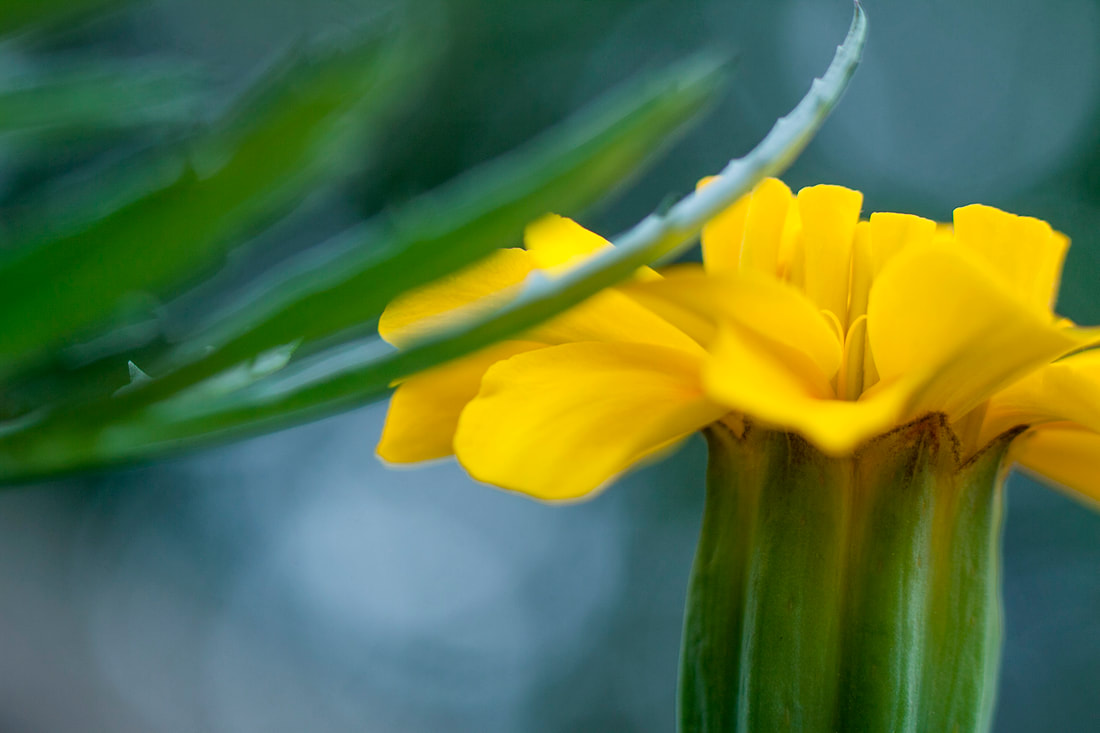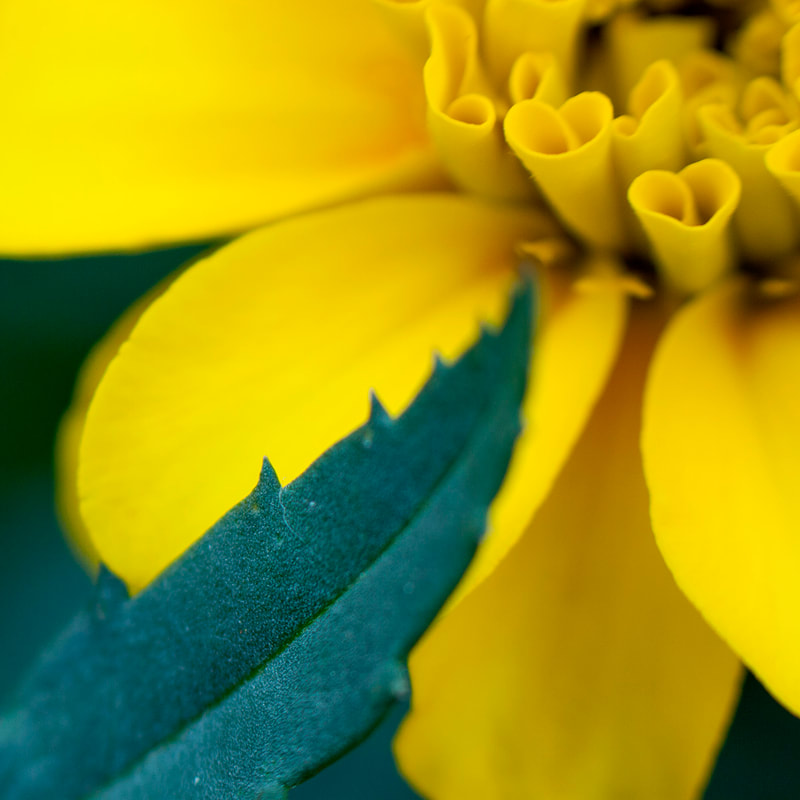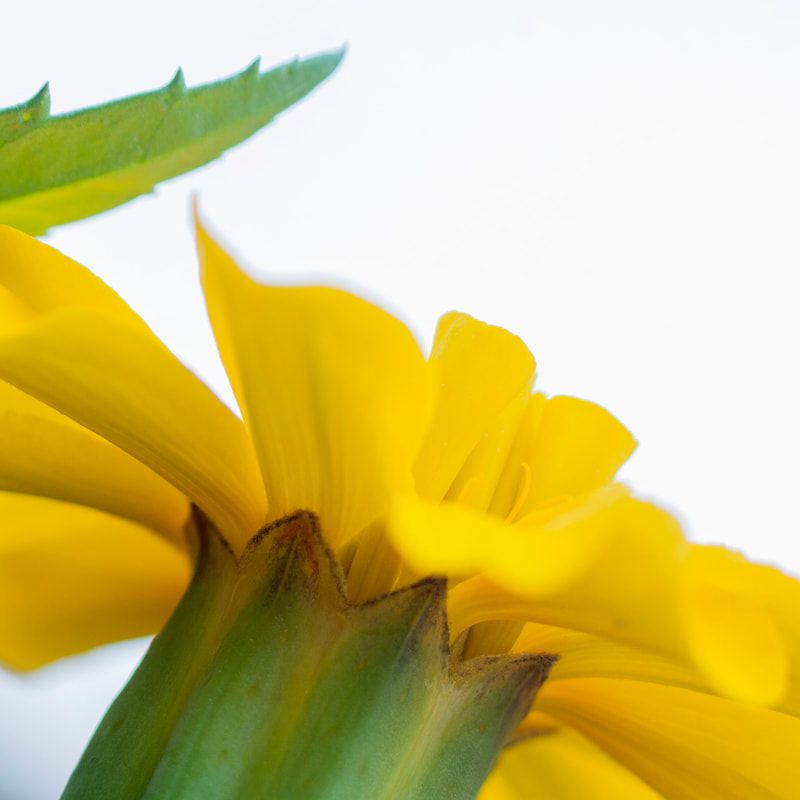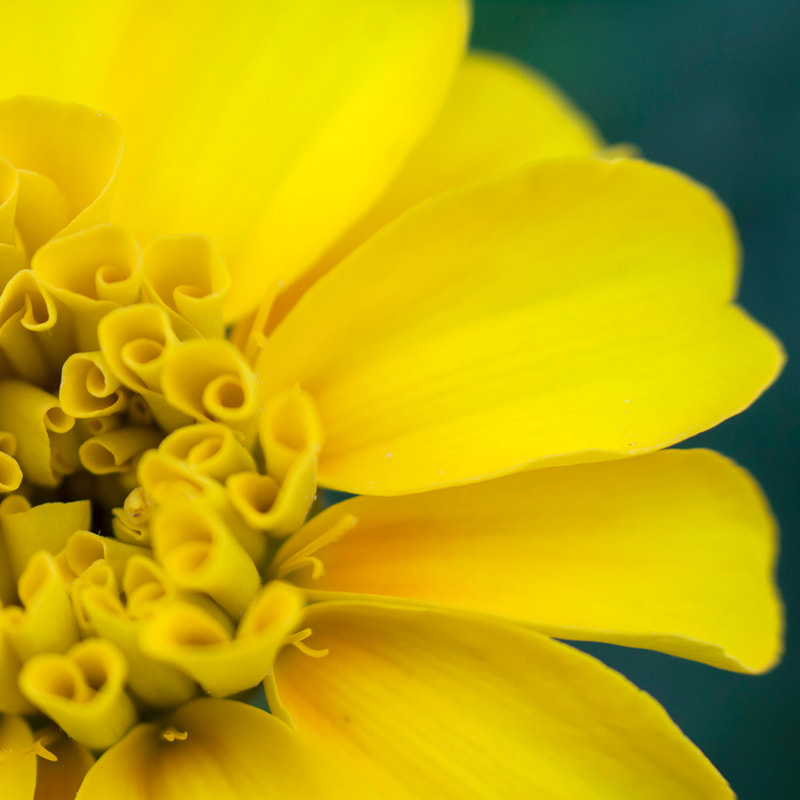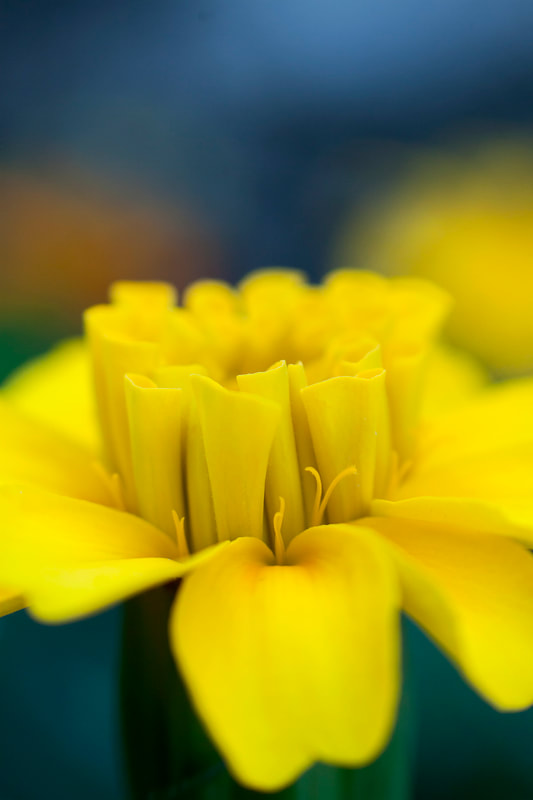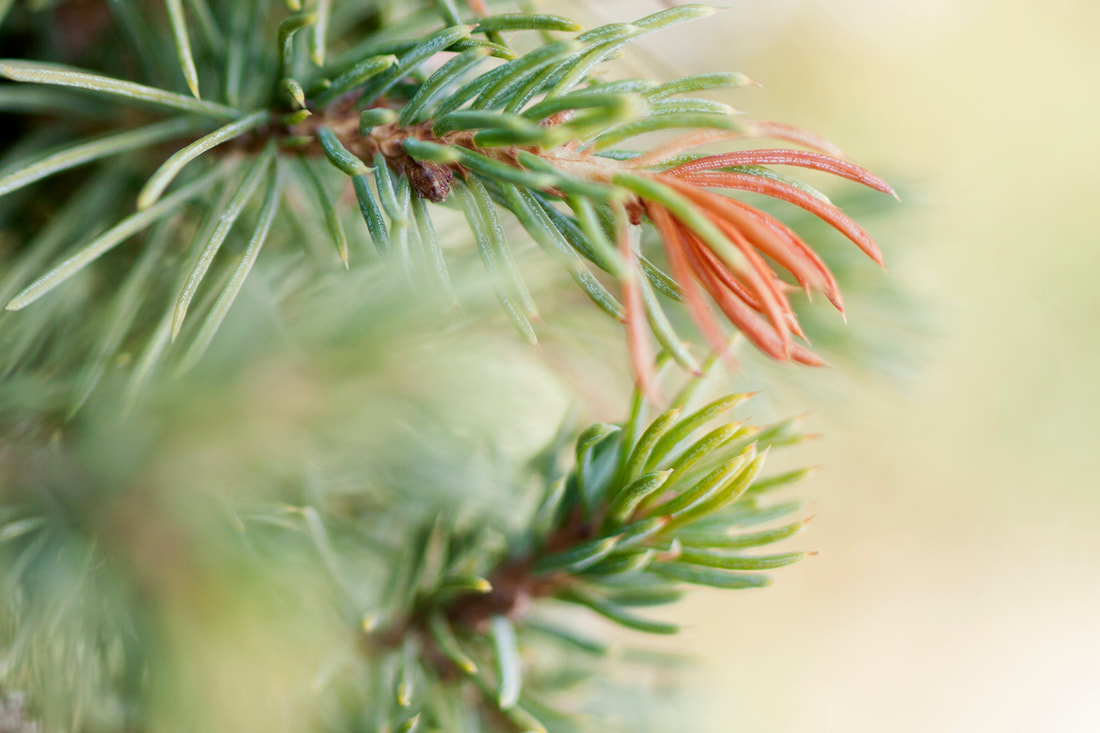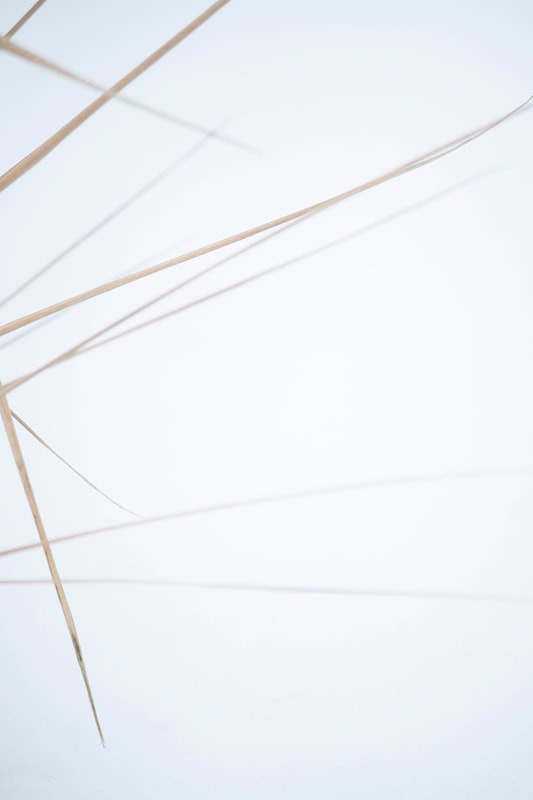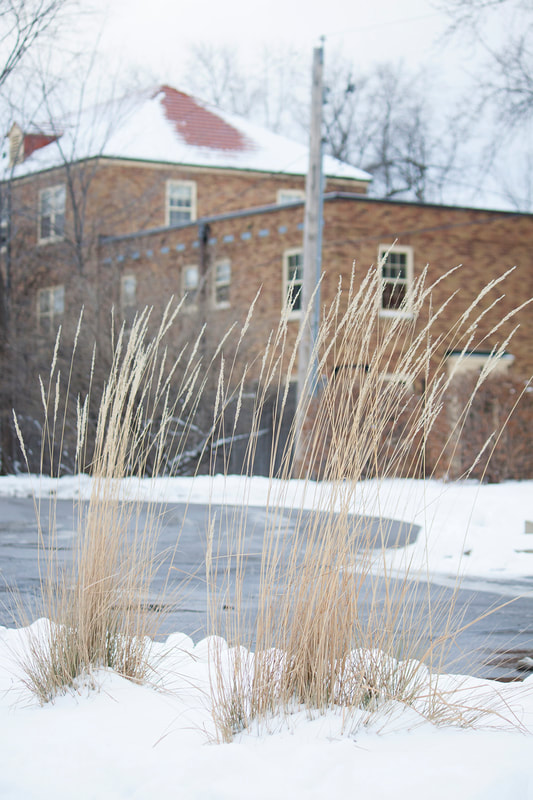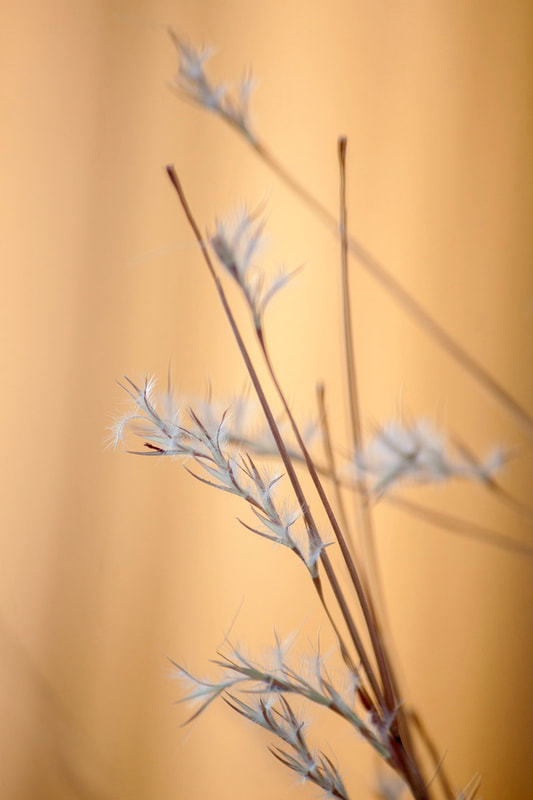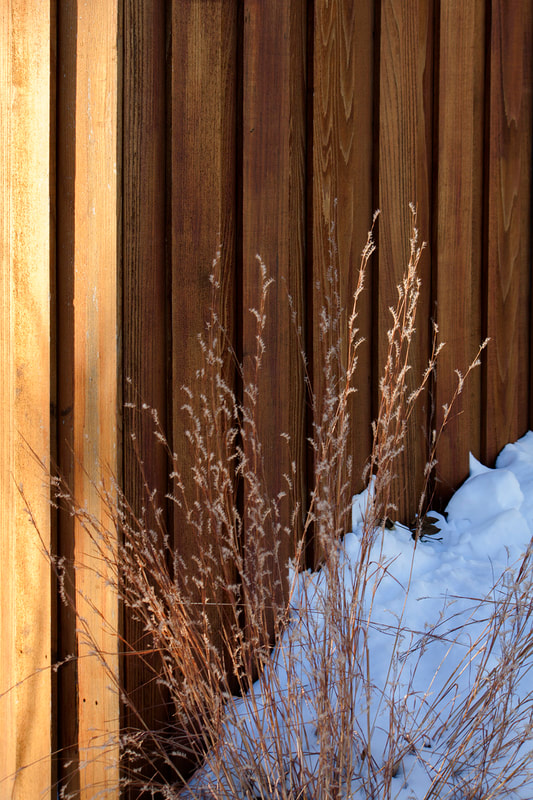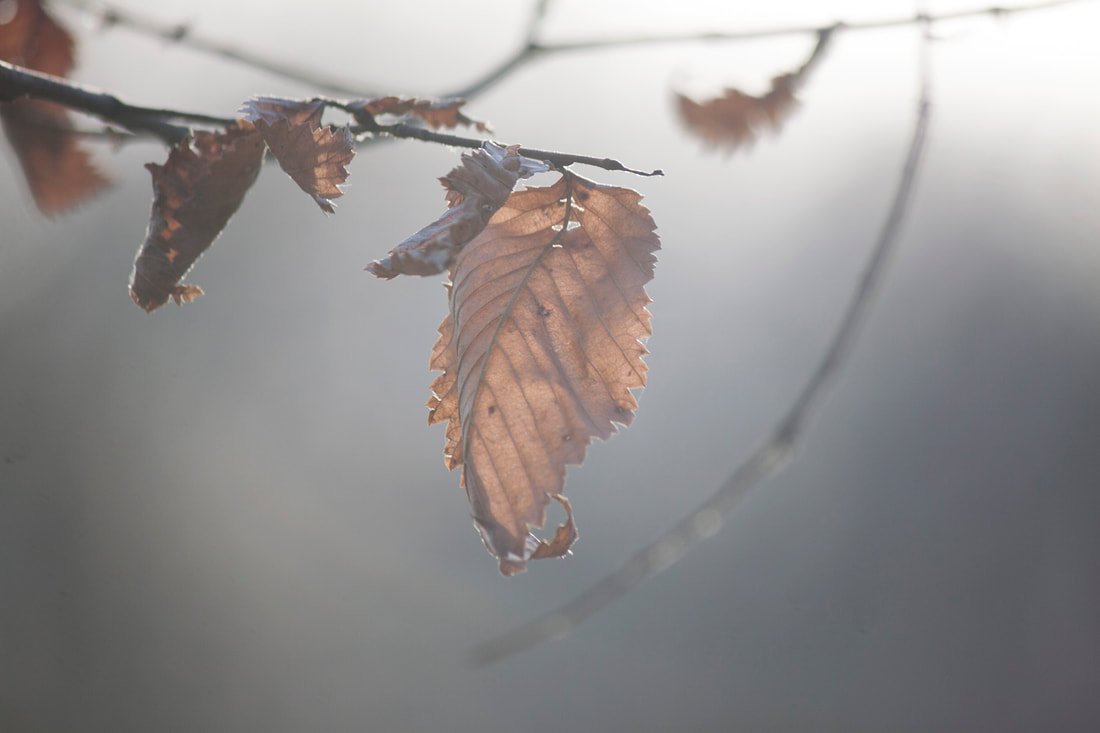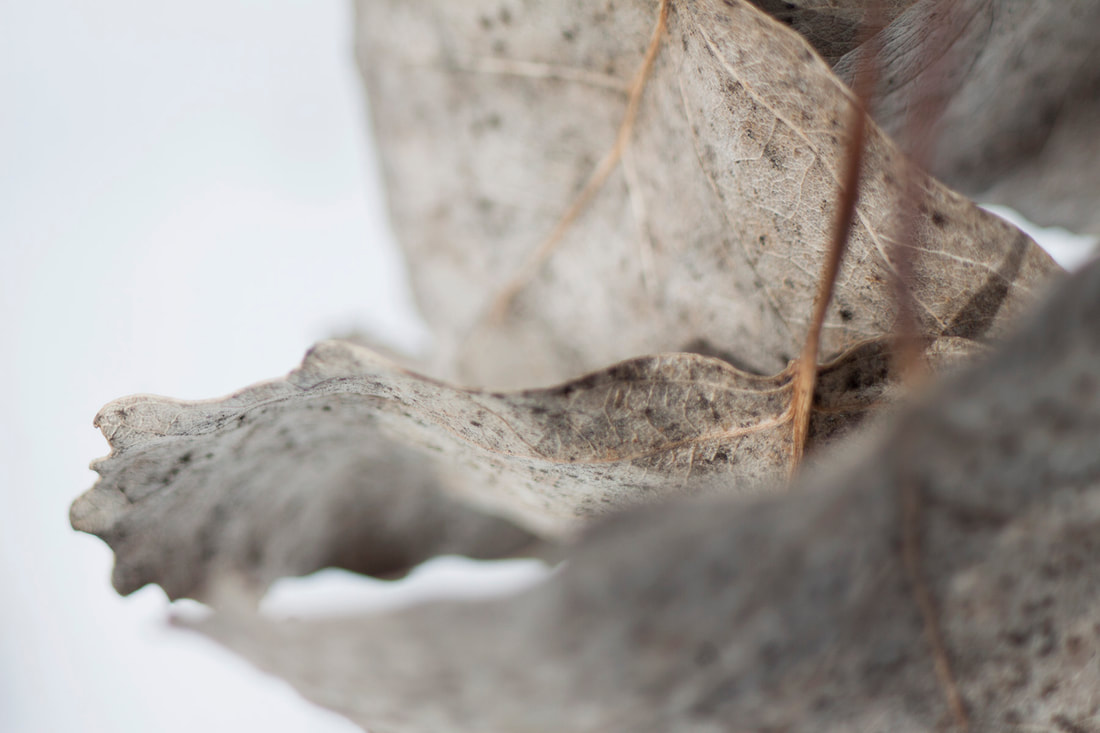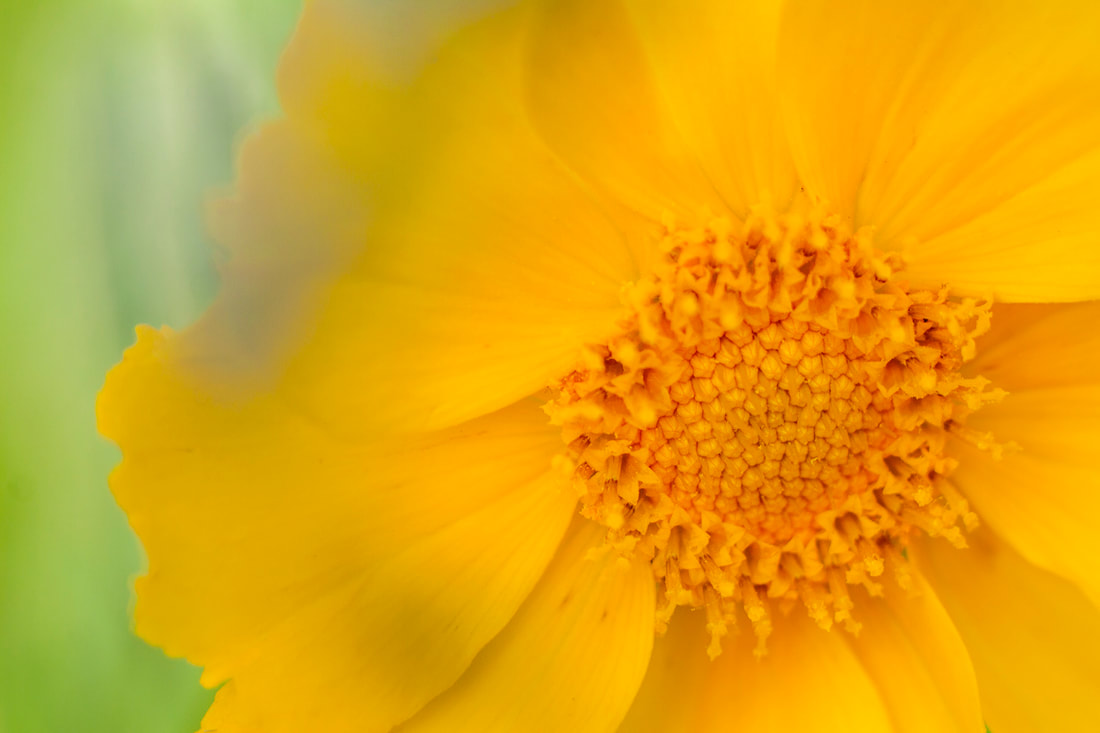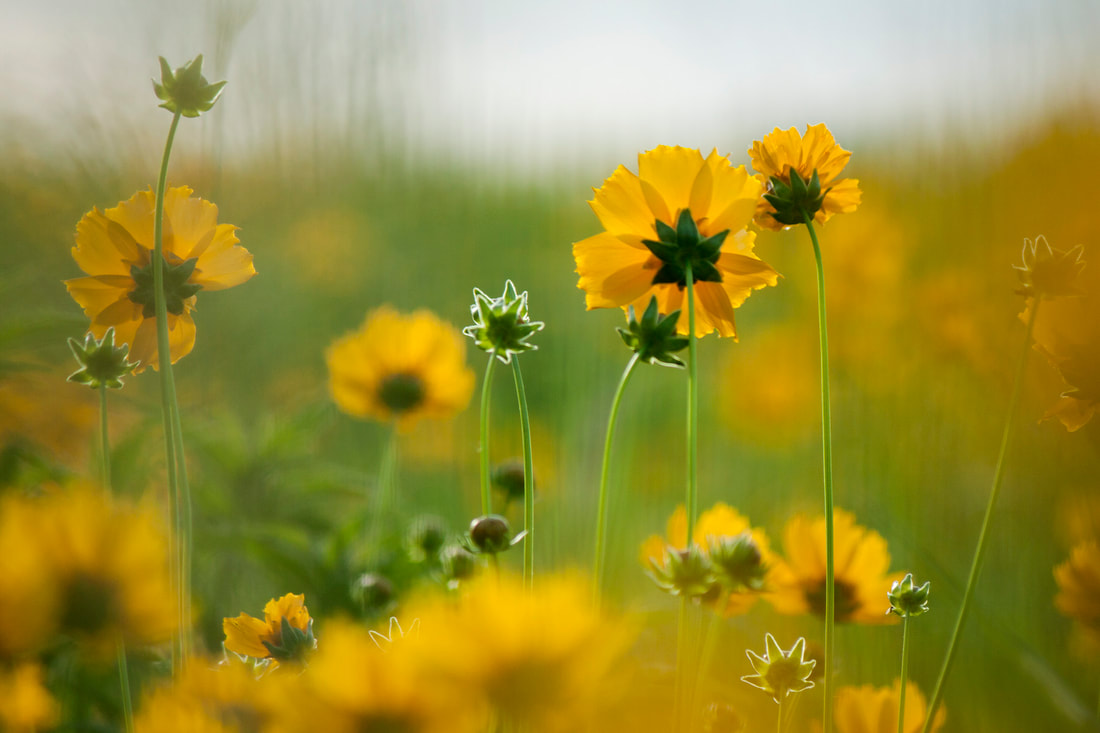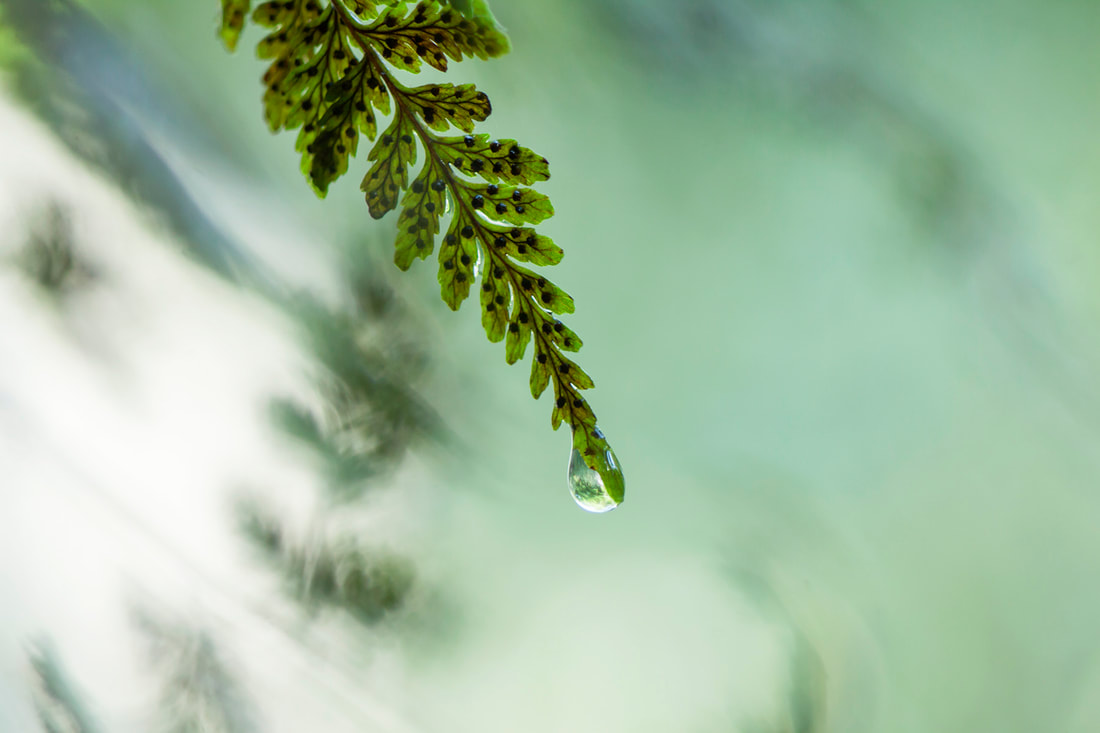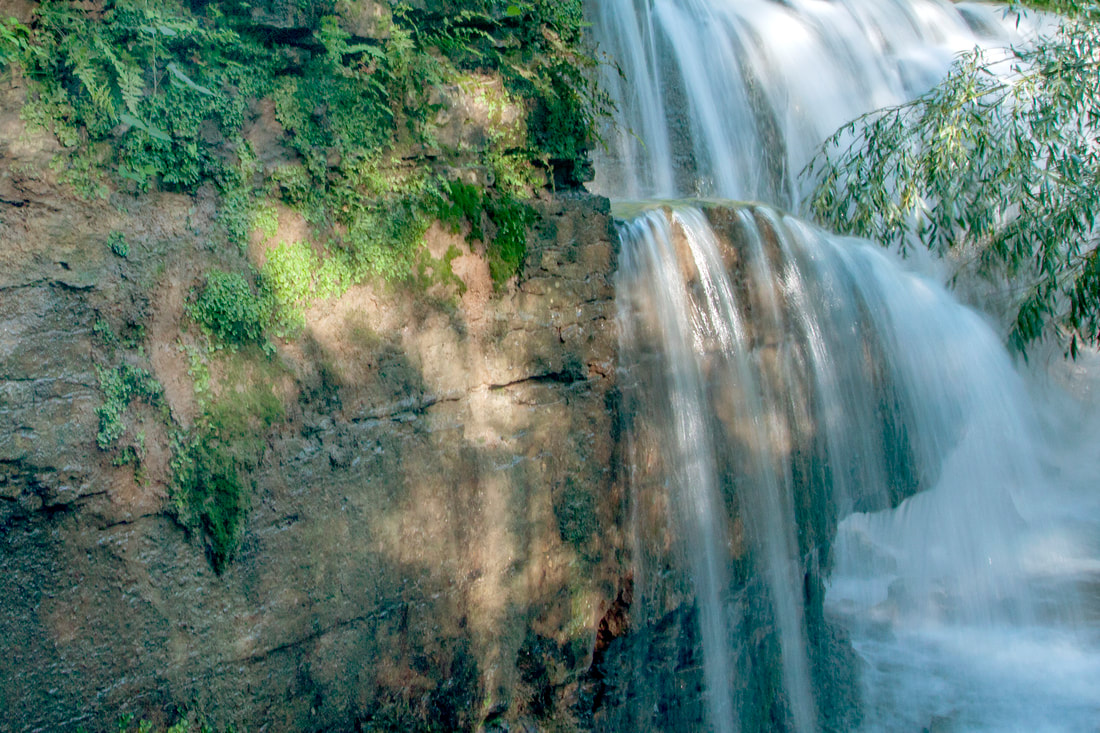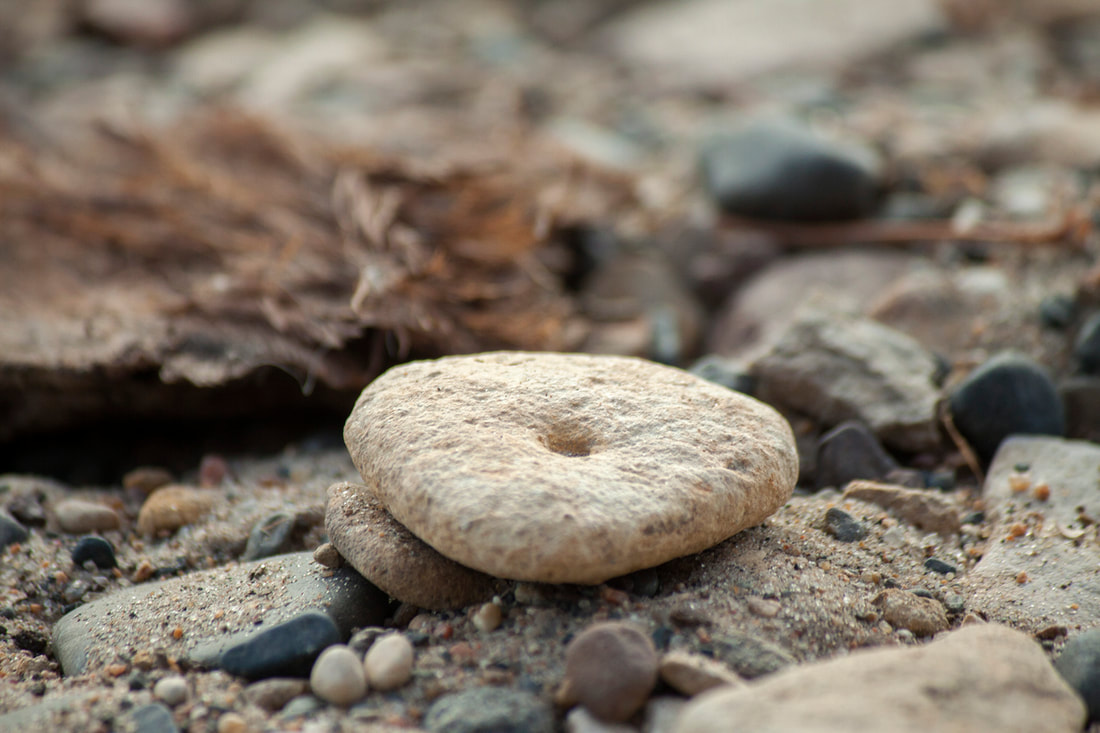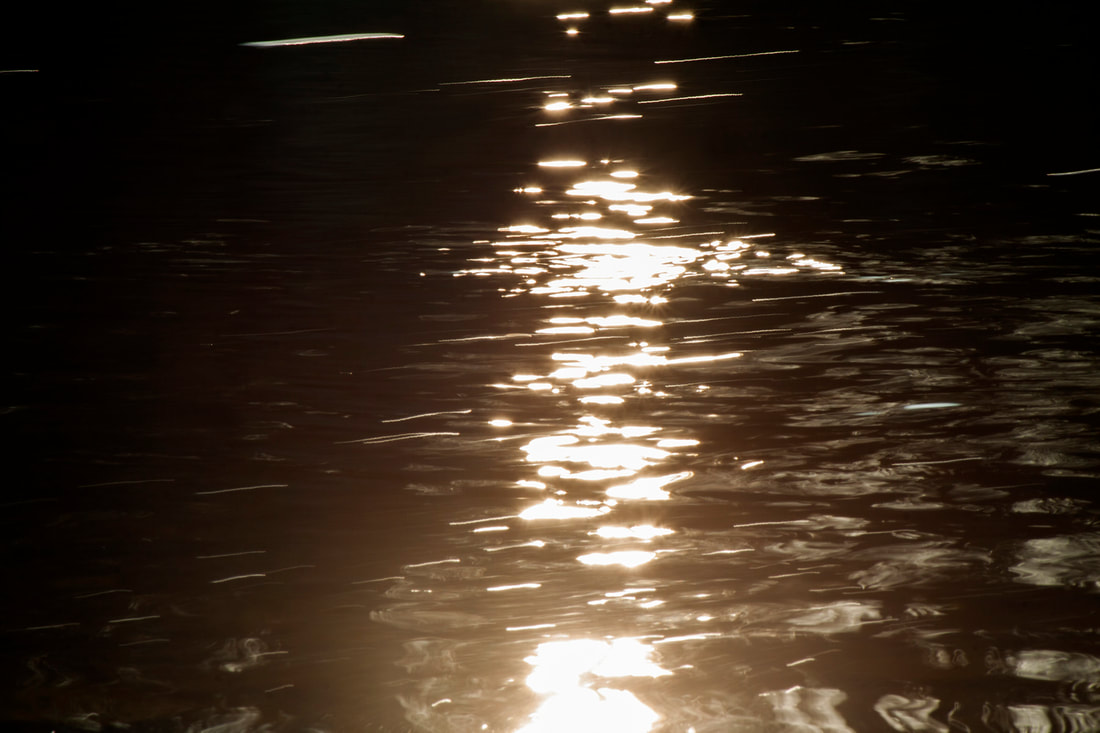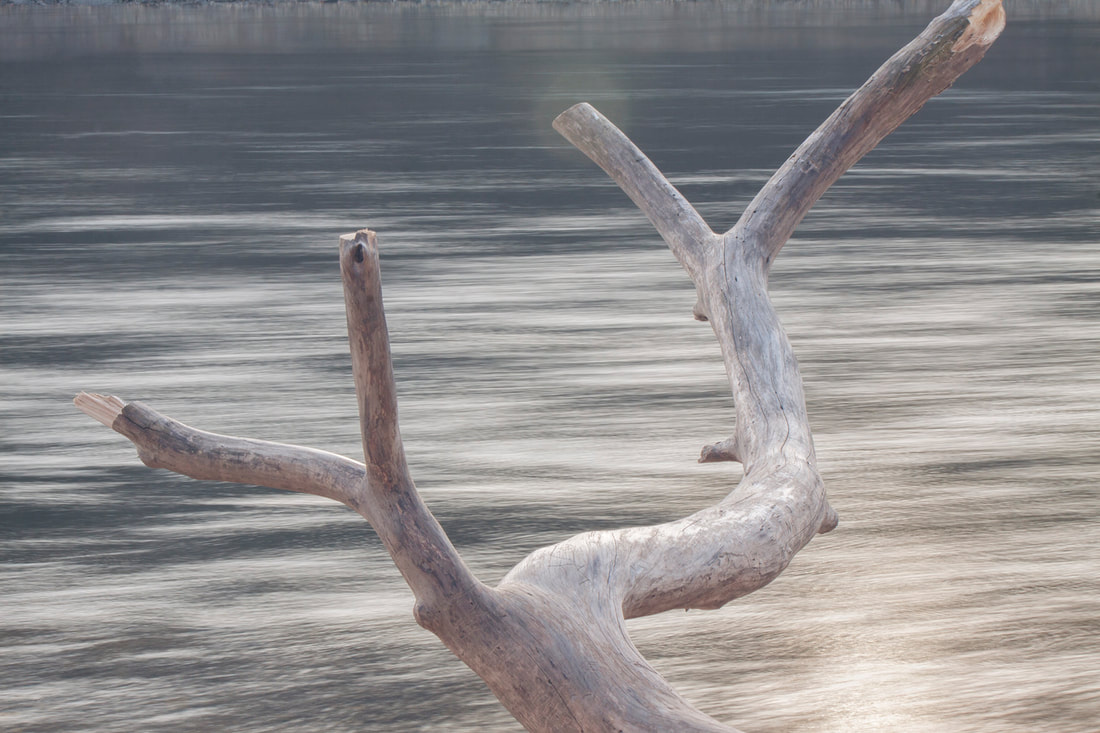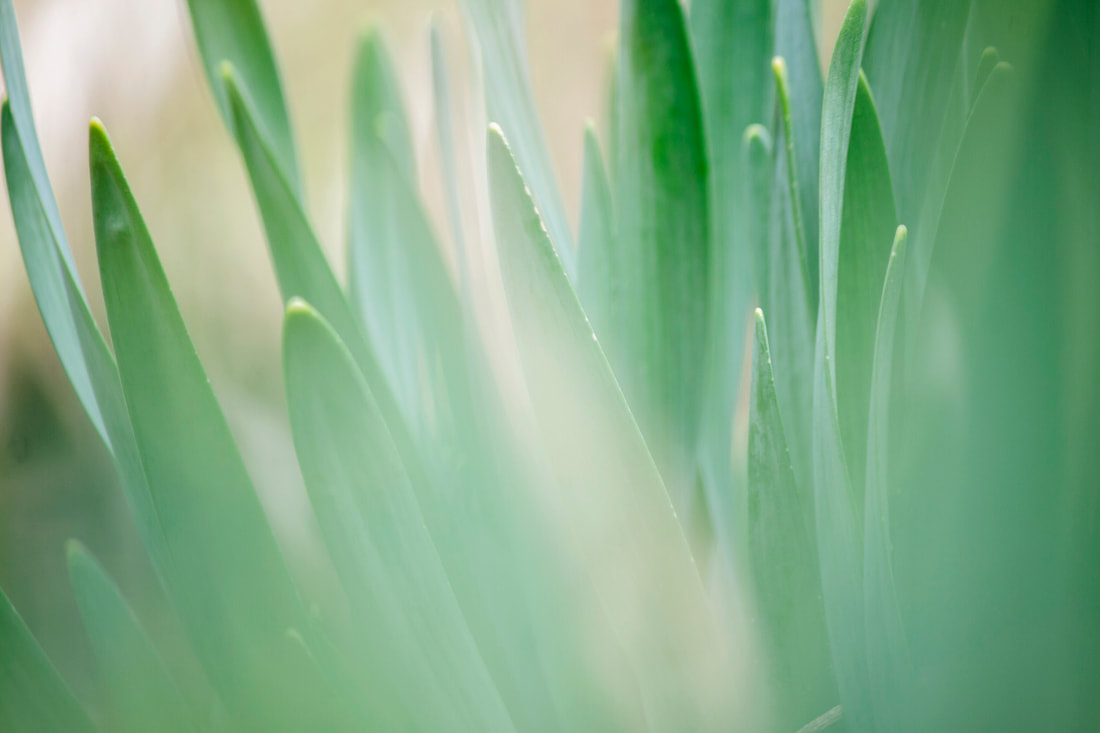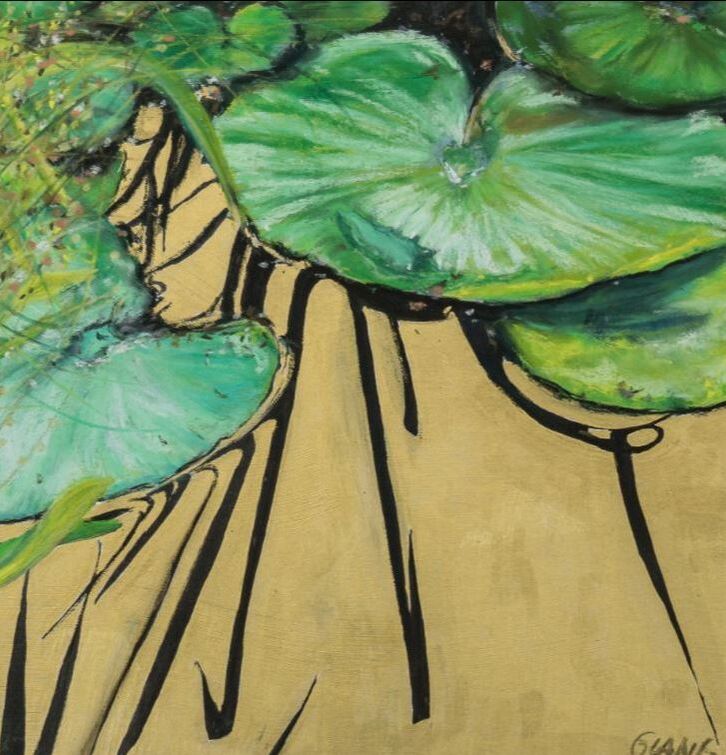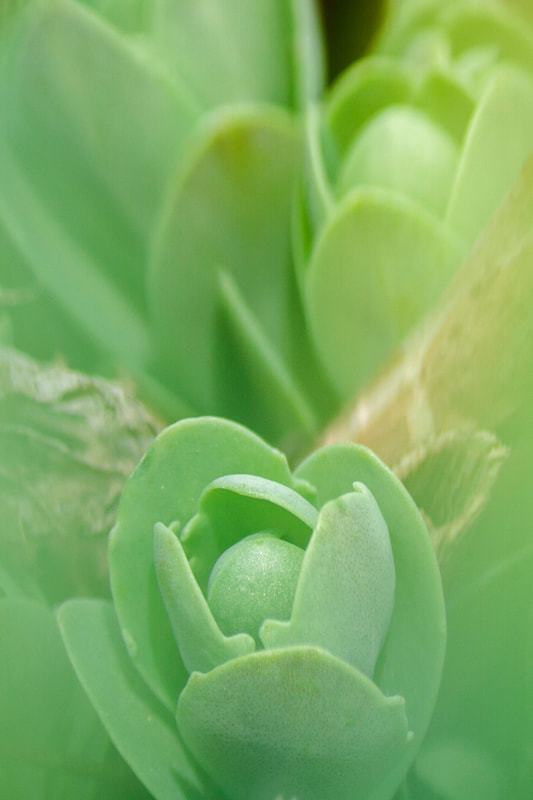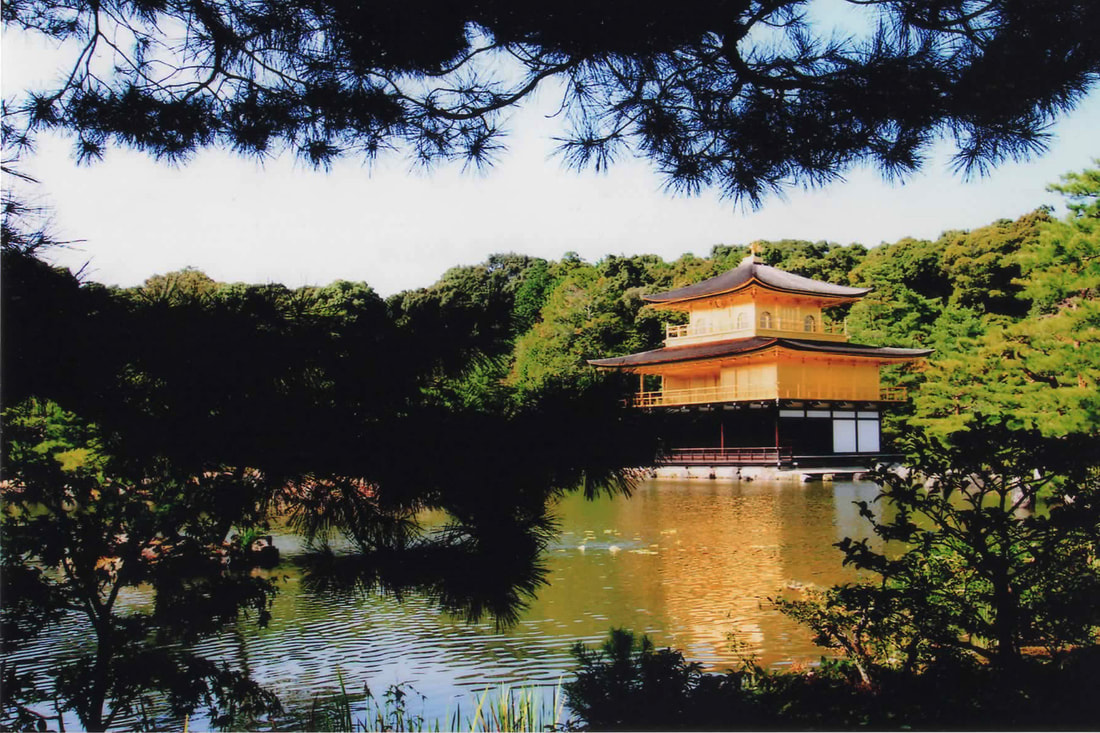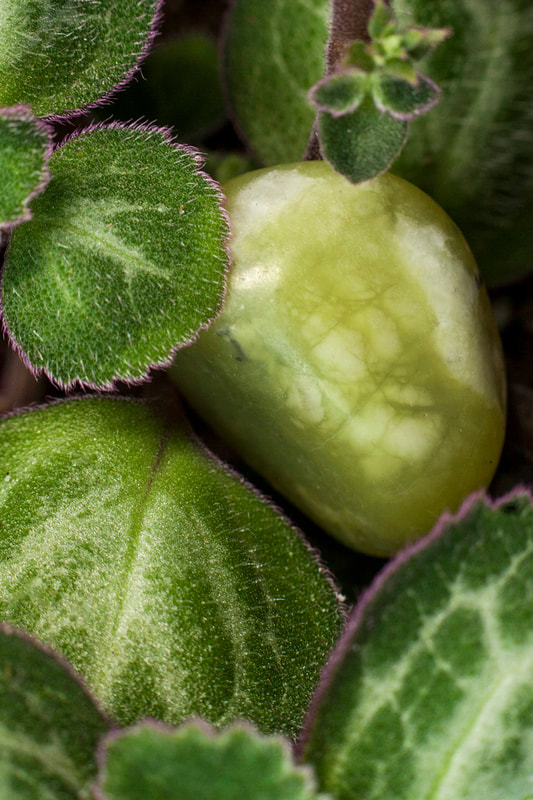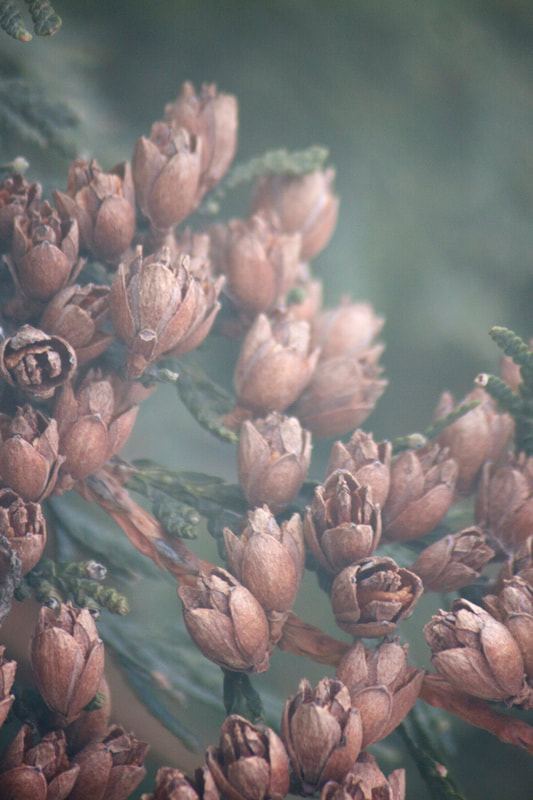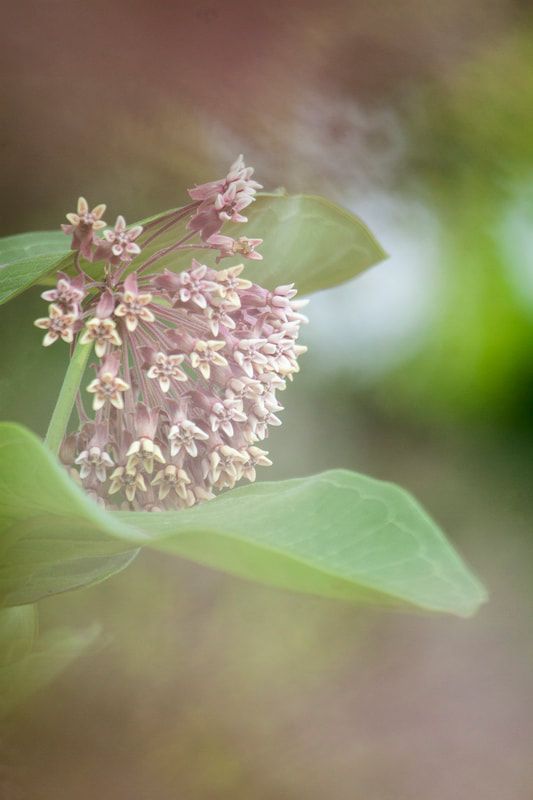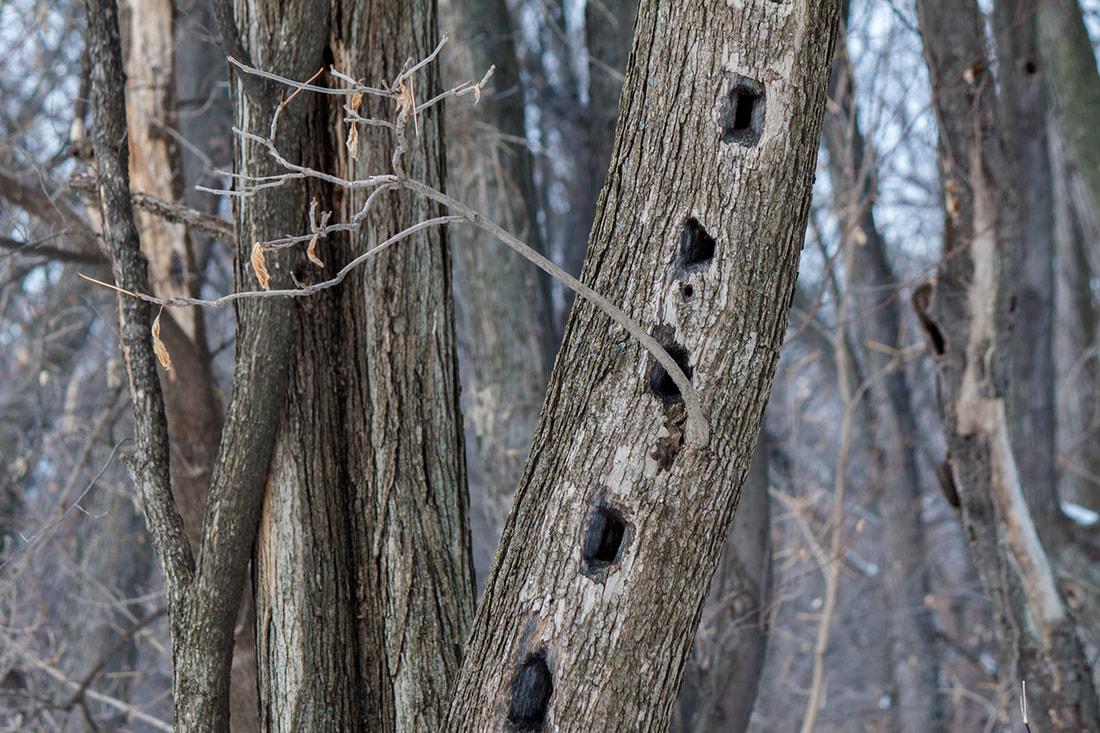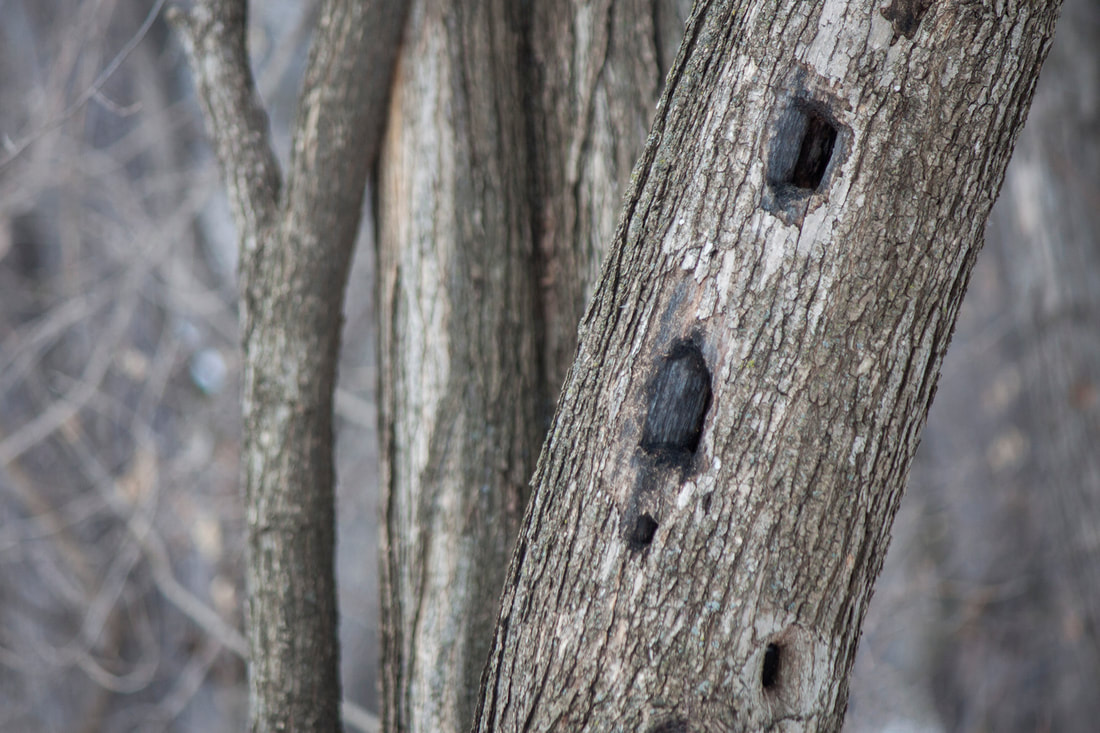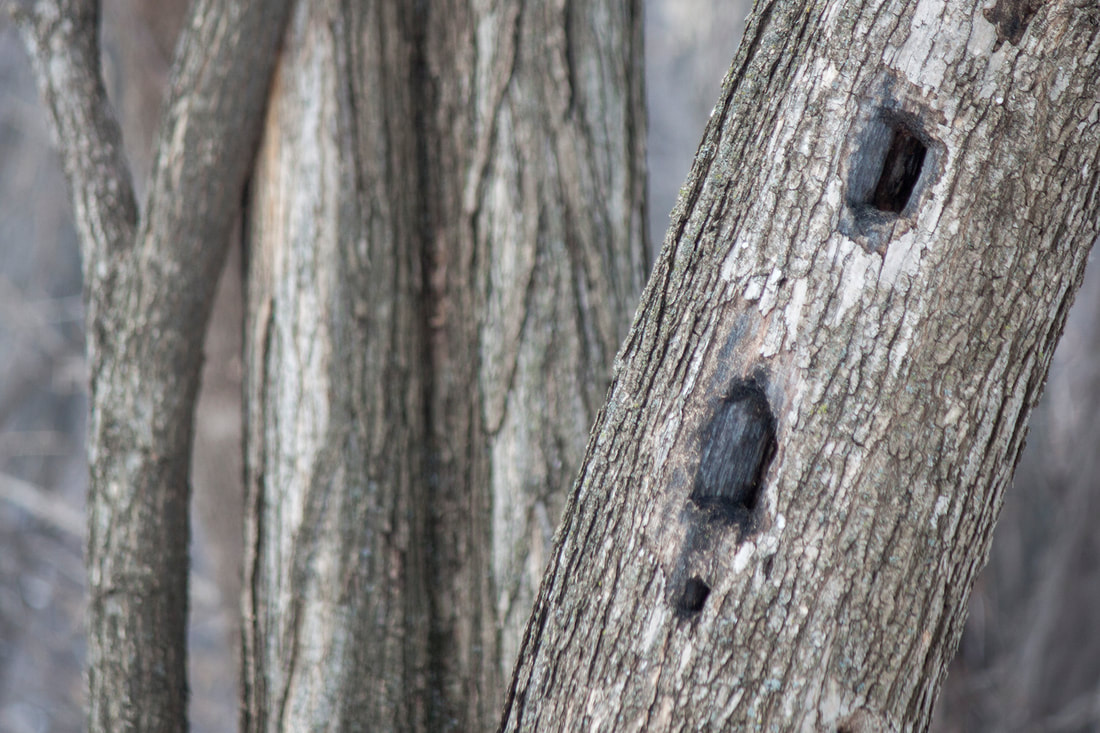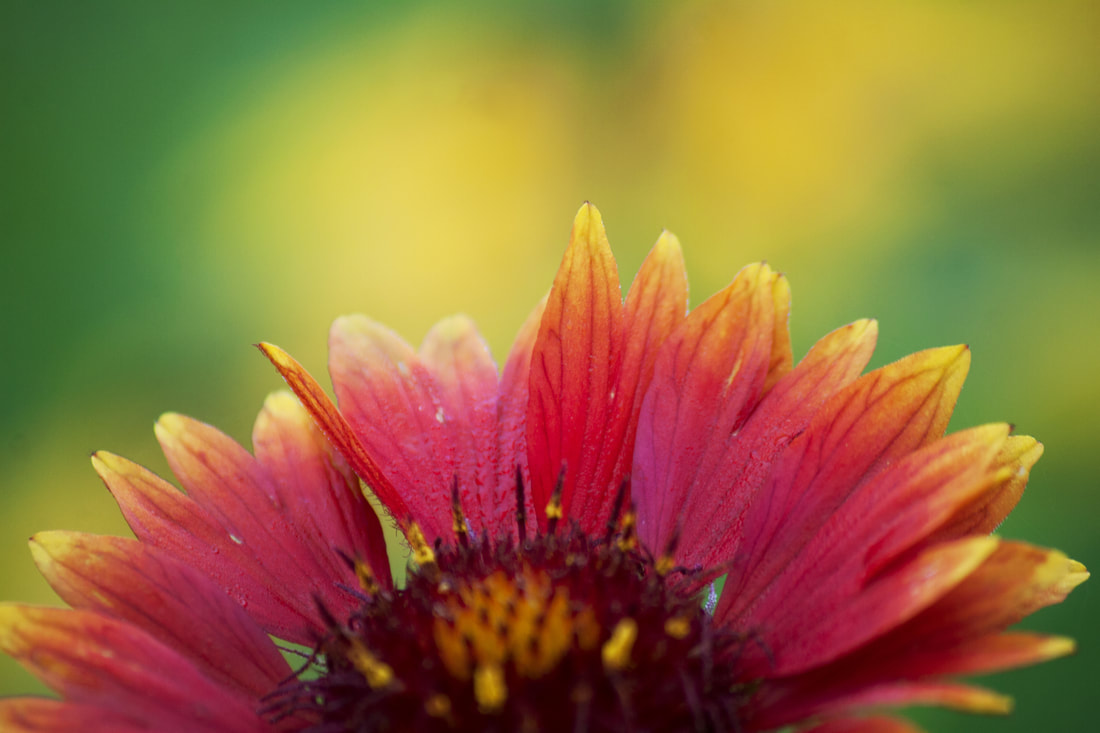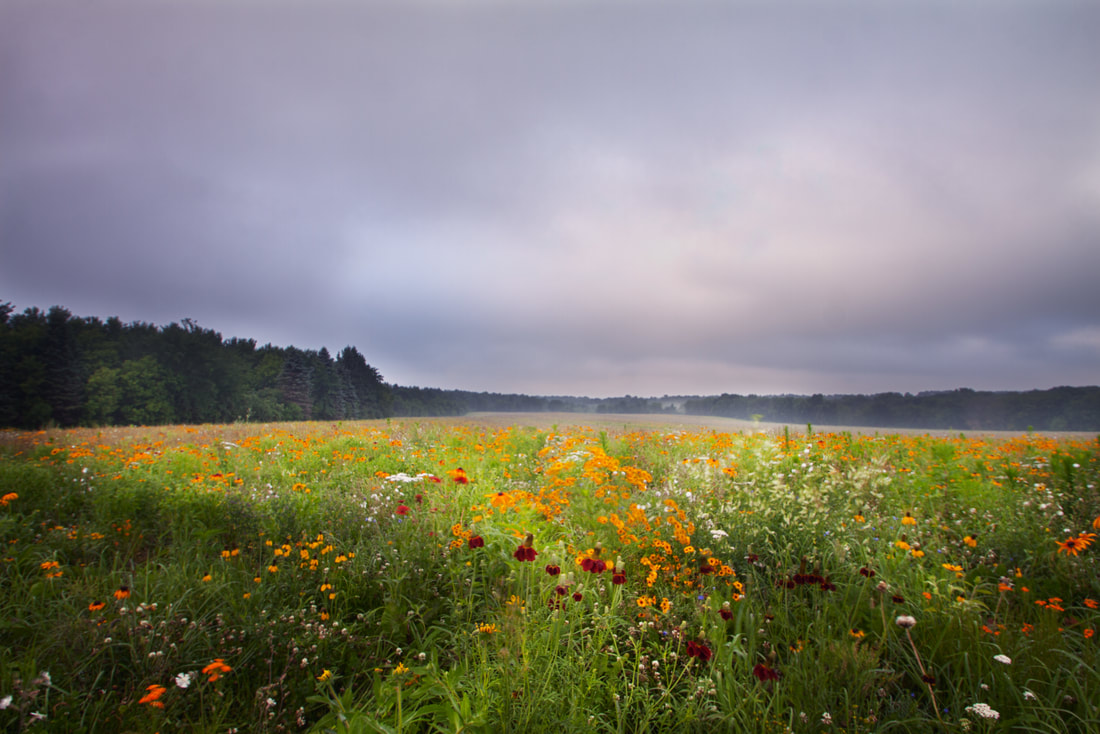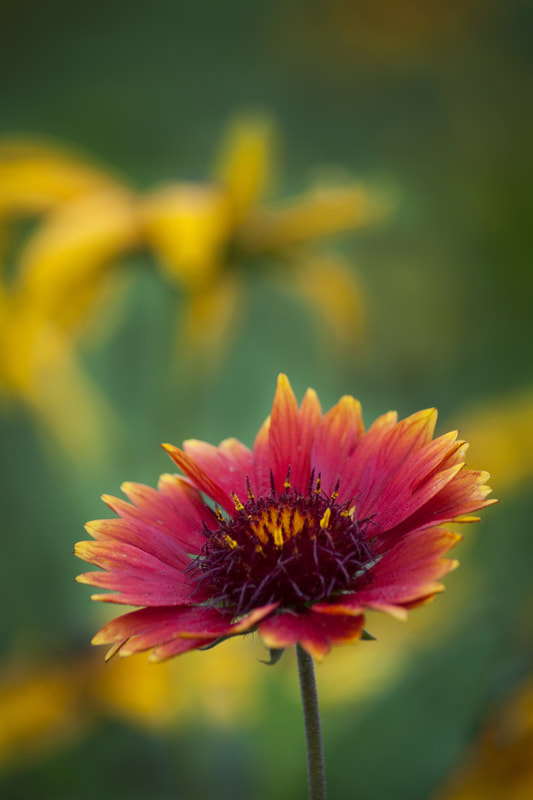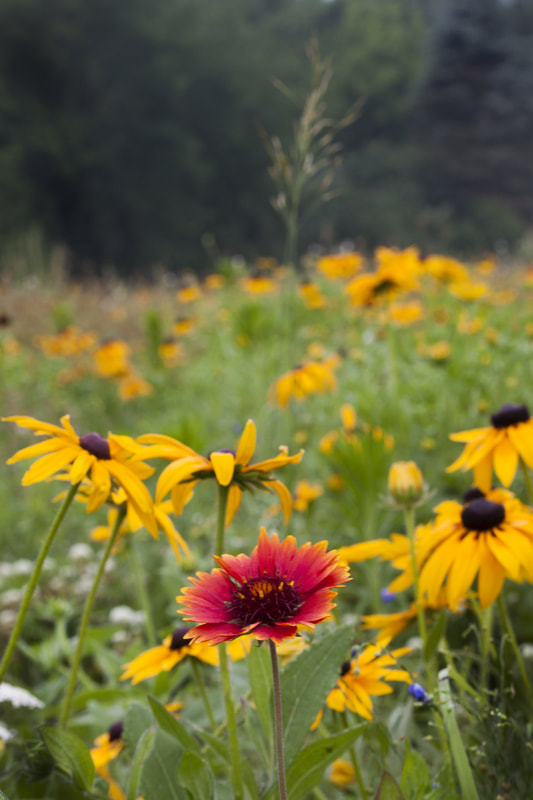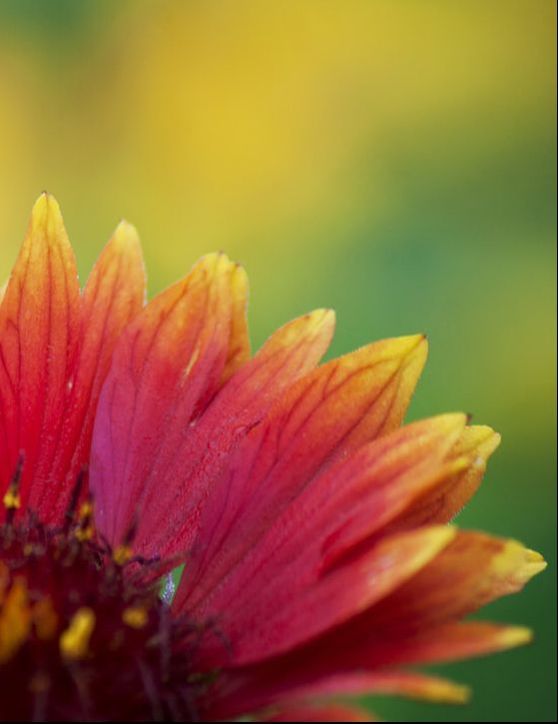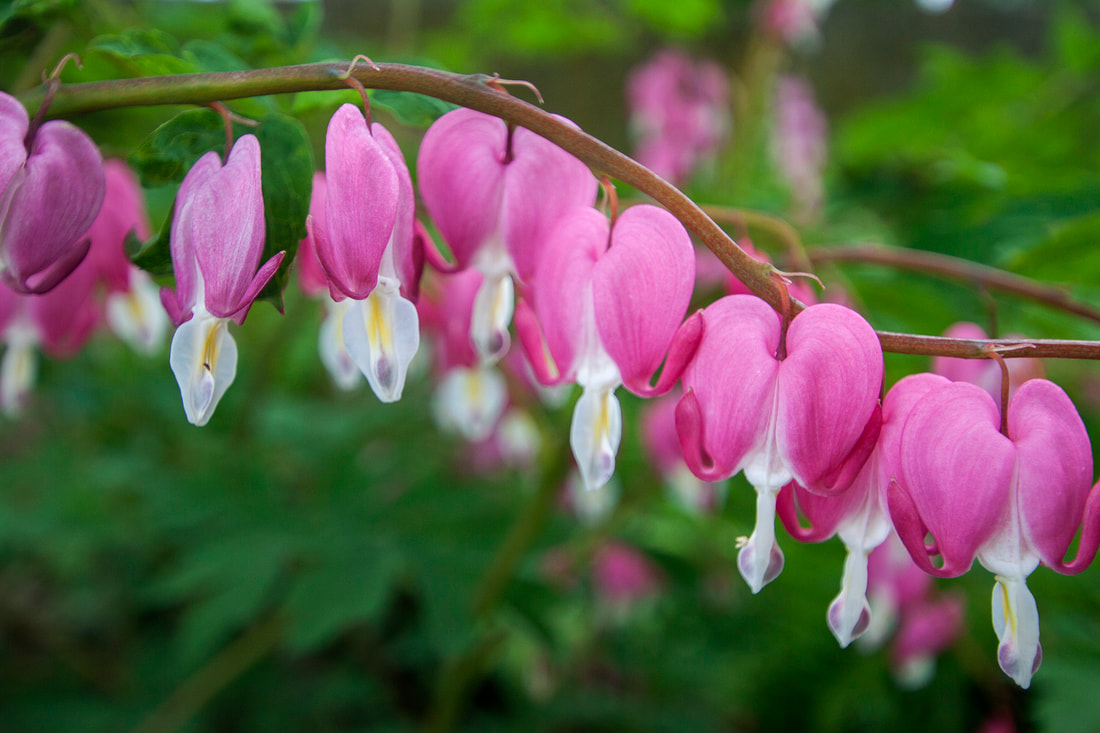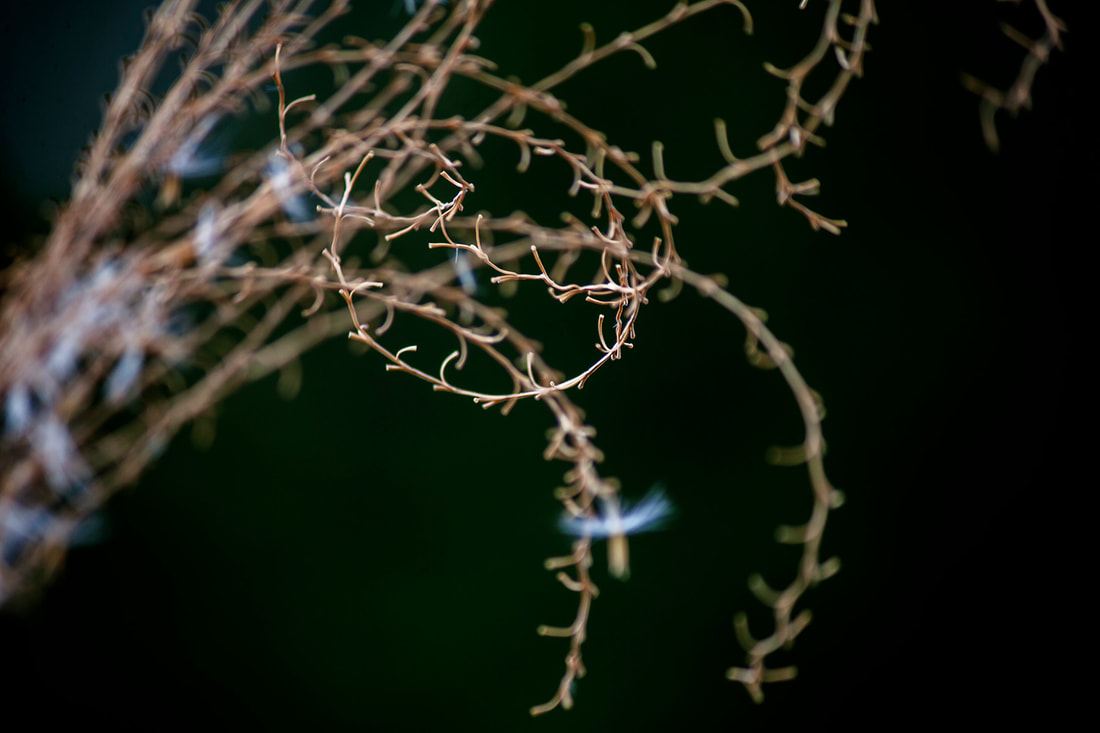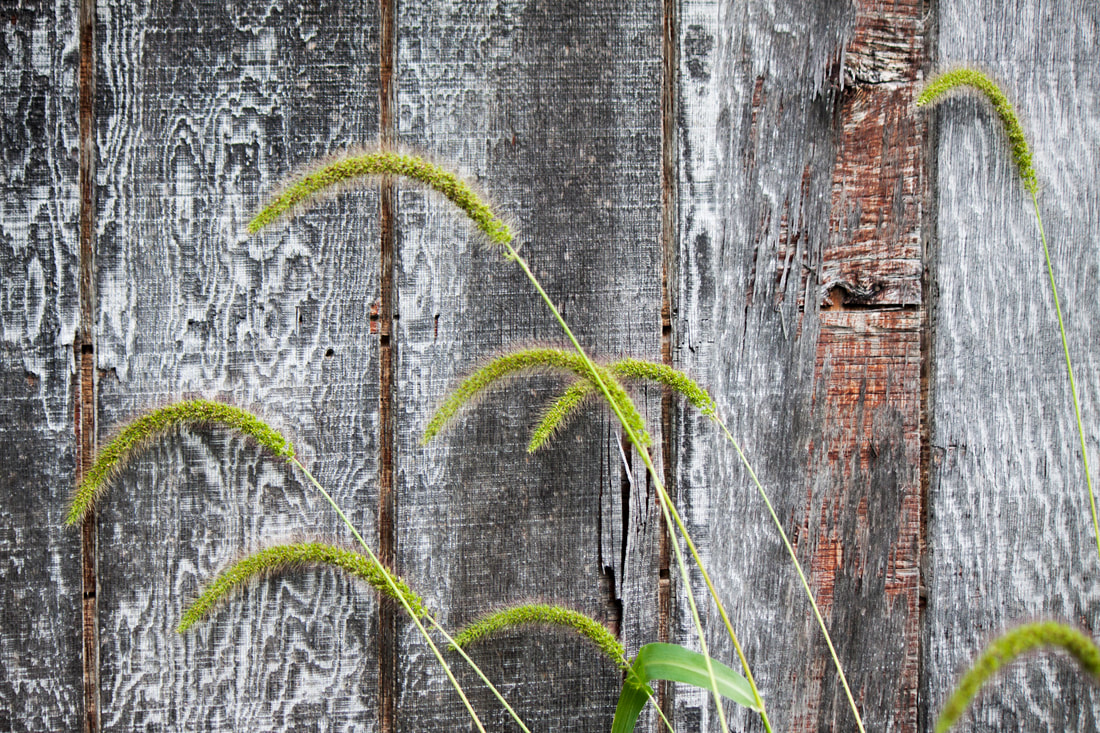Expand your nature connections |
| Texture: Marigold foliage is angular and spiked, but the blossoms are smooth and fluid. Opposing textures adds variety. We can imagine marigolds as hosting a party where all are welcome! | Color: Analogous colors (colors next to each other on the color wheel) typically lend a sense of restfulness, but marigold's bright hues create a more vibrant and youthful quality. We can imagine marigolds as childhood friends who stick together. | Shape: Circles offer a feeling of connection, wholeness, timelessness, and cyclical movement. We can imagine the marigold community as an endless ring of belonging. Read more on shapes here. |
| Mindfulness through photography helped me engage with a subject I'd typically avoid, the marigold taught me to listen deeply and my camera allowed me to see complex beauty where my eyes/brain/nose felt displeased. Channel the message of the marigold in your own practice by photographing something that disgusts you. Try deepening your curiosity about something you might initially overlook or be turned off by. As you photograph, notice both the subject and your own feelings, for better or worse. Stay attuned to subtle shifts that create an opening, a softening when you turn your attention to how your camera sees this subject. |
What "disgusting" object will you connect with through mindful photography?
EXPANDing "nature Photographer"
Because I am woman who enjoys photographing solo, I often struggle with calling myself a nature photographer. Over the years, I've grappled comparing myself with the image I have of nature photographers who go out into wild locations in extreme conditions. With my circumstances and desire to use nature photography to restore my body and mind, I had to accept that I need to keep my practice simple and safe. Here are a few things I do to keep myself comfortable out in nature, even if not typical practices for many nature photographers.
I travel light and keep my practice simple.
I keep daylight hours.
I center myself and my relationship with nature.
I honor my comfort-zone.
- Visit the Slow Photography Movement's blog to read my article "Relational Nature Photography."
I keep daylight hours.
- Visit the Slow Photography Movement's gallery "There is No Bad Light" for a collection of images made in full sun.
I center myself and my relationship with nature.
- Read my blog using lines and shapes to notice and honor your subject's energy.
I honor my comfort-zone.
- Read below for the benefits of practicing nature photography in the city.
Staying close to home this winter provided me a bit of comfort and connection with the natural world during a season short on daylight hours. At first, I struggled with the idea that what I was practicing was nature photography, but overtime I realized that there are many ways to connect with nature and many ways to serve as nature photographer.
Not all of us have the same relationship with the outdoors. That doesn't make those of us who take fewer risks are less worthy storytellers or nature lovers. Let's not be afraid to share, witness, and embrace the unconventional stories. Instead, let's allow and celebrate complexity within nature photography and the locations where we feel a connection.
When have you expanded your definition of traditional labels?
choose supportive styles
If we are paying attention, nature has a way of supporting our ever-changing emotional needs.
Macro photography is my main style of expression. I find that when I take time to appreciate the little things, I'm less likely to take life for granted. When I focus on everyday beauty, I find contentment no matter where I am.
Macro photography is my main style of expression. I find that when I take time to appreciate the little things, I'm less likely to take life for granted. When I focus on everyday beauty, I find contentment no matter where I am.
Macro supports me with feelings of closeness and simplicity.
Try using macro when you're feeling overwhelmed and need comfort.
Try using macro when you're feeling overwhelmed and need comfort.
Landscapes support me with feelings of interconnection and expansion.
Try using landscapes when you're feeling ungrounded and need connection.
Try using landscapes when you're feeling ungrounded and need connection.
If you're feeling overwhelmed or want to focus on comfort, try framing the little details around you. If you're feeling ungrounded or want to focus on connection, try framing the bigger picture. If you're not sure how you feel or what you want, try both and see what may arise.
How will you use different photos styles to support you?
Embrace Subtle Beauty
If we are paying attention, our personal stories have the possibility of influencing our photographic style.
Point-and-shoot was my basic strategy for making images the first many years of my photography practice - even after going to school for photography, knowing all the rules, and possessing the technical skills. Don't get me wrong, there are benefits to making snapshots and I still make them 21 years post-graduation. Practice is vital for refining your art, but continual refinement and clear intentions is what differentiates snapshots from art.
It wasn't until I had life experience, a refined perspective on beauty, and something I felt I needed to say that I finally began to use my camera settings and the rules of composition in an intentional way. In other words, I may have known what I was doing, but I didn't know why or what I was trying to say.
Recently, I was reflecting on whether or not my imagers were communicating my intentions when artist & poet Gabriele Glang gifted me with this compliment, "Imperfection, wabi-sabi, haiku - I'm thinking your images are beautiful because they are spare, focused, elegant, concise. In fact, they are poems, to my mind."
Wabi-sabi and haiku are Japanese artistic concepts, and my photographic style was informed by a life-changing experience in Japan. Feeling seen in this way inspired me to share a few ideas about how I create photographic poems.
Point-and-shoot was my basic strategy for making images the first many years of my photography practice - even after going to school for photography, knowing all the rules, and possessing the technical skills. Don't get me wrong, there are benefits to making snapshots and I still make them 21 years post-graduation. Practice is vital for refining your art, but continual refinement and clear intentions is what differentiates snapshots from art.
It wasn't until I had life experience, a refined perspective on beauty, and something I felt I needed to say that I finally began to use my camera settings and the rules of composition in an intentional way. In other words, I may have known what I was doing, but I didn't know why or what I was trying to say.
Recently, I was reflecting on whether or not my imagers were communicating my intentions when artist & poet Gabriele Glang gifted me with this compliment, "Imperfection, wabi-sabi, haiku - I'm thinking your images are beautiful because they are spare, focused, elegant, concise. In fact, they are poems, to my mind."
Wabi-sabi and haiku are Japanese artistic concepts, and my photographic style was informed by a life-changing experience in Japan. Feeling seen in this way inspired me to share a few ideas about how I create photographic poems.
| Before I share my ideas, let's take a moment to breathe in this elegant painting by Gabriele from her "Pond" series, where she returned to the same pond over and over, sensing its subtle beauty through the seasons. Visit Gabriele's poetic pond paintings here. |
| Back in Japan, I learned about the design concept miegakure (hide and reveal) which gave me the seed for how I wanted to transform my photographic story. Miegakure is used to create awe-inspiring gardens that encourage visitors to slow down, to contemplate, to experience mystery and anticipation. A similar approach is seen in Yamato-e style art, where clouds and mist are used to obscure parts of narratives told through large scroll or screen paintings. The idea behind this aesthetic style reminds the viewer that life is a mystery, that imagination is vital, and it suggests you'll never know the complete story. |
| Enjoy a few of my favorite Japanese photographers: Nyoro: See their work here. Follow them on Instagram here. Eiichiro: Watch their short film here. Follow them on Instagram here. akiyama: See their work here. Follow them on Instagram here. fujicco: Follow them on Twitter here. Follow them on Instagram here. |
Experiencing the beauty of mystery in my own life, this aesthetic resonated with me - it even helped me reframe some of the most difficult events in my life. Over the years, I have been learning to be less concerned with controlling situations and demanding tidy answers to life circumstances, preferring to instead to revel in a slow unfolding of this human drama.
And with that intention for my life, I have been experimenting and slowly refining my artistic voice to express delight in our world's subtle, mysterious beauty.
Here are a few ideas for adding subtle beauty to your images:
And with that intention for my life, I have been experimenting and slowly refining my artistic voice to express delight in our world's subtle, mysterious beauty.
Here are a few ideas for adding subtle beauty to your images:
| Try looking for hidden subjects. Often, I find my subject nestled within shrubs, rocks, leaves, etc. Use the "nest" to hide elements of your main subject. For this image, I intentionally placed my jade rock (also from Japan) within my houseplant during a mindful photography event hosted by Tonya Peele on the meditation app, Insight Timer. | Try breathing on the lens (put a UV filter on your lens to prevent damage) before making your image - the results are unpredictable, uncontrollable, and impermanent. And also soft and subtle. For a deeper perspective on the breath and why I believe subtle beauty is important to the culture of nature photography, read my article "Relational Nature Photography" on the Slow Photography Movement blog. |
| Try framing your main subject through foliage in the foreground, right up close to your lens. This gives a "painterly" effect. I was able to do this much more intentionally after watching Kathleen Clemons' course "Creating Painterly Photographs" on Creative Live. | Try simplifying your composition by getting clear about your subject and using your camera to support your intention. For ideas on how your camera can help you, read my blog "Into Simplicity". |
We have all been directly confronted with life's mysteries as we live our way through a global pandemic. When you find yourself trying to control or rush to figure it all out, try taking a stroll through nature and turning your concerns over to her subtle beauty.
How will you bring subtle beauty to your images?
Nourish your LIfe and Photo Practice
Kim Manley Ort and her 2021 project "Seeing Clearly" prompted me to listen for sounds out in the woods on a winter afternoon. With that intention, I heard the woodpeckers.
Specifically, I heard a Pileated Woodpecker. For a more biological and ecological perspective on this amazing bird, please read this creatively written blog by Ken Bevis, a DNR Stewardship Wildlife Biologist, "Just About the Coolest Bird Around: the Pileated Woodpecker."
Specifically, I heard a Pileated Woodpecker. For a more biological and ecological perspective on this amazing bird, please read this creatively written blog by Ken Bevis, a DNR Stewardship Wildlife Biologist, "Just About the Coolest Bird Around: the Pileated Woodpecker."
| In the woods, I heard the knocking first and, when I froze on the path to locate the source, I heard tree bark raining down directly in front of me. And there was Woody, pecking away! Side note: I do not have the gear or the skill for bird photography. Please enjoy this playful image by Jeanette Mayo. See more of Jeanette's work here. |
I watched this woodpecker continue to peck at the exact same spot. Sure, there were micro-movements, but this bird never jumped trees or even to a new spot on the same tree.
Woodpeckers don’t move when nourishment is being received and, when nourishment ends, they fly away, laughing joyfully!
During my photo practice that afternoon, I followed the woodpecker's lead and made micro-movements between exposures. Here's an example of how minor movements can change an image. What do you notice about how the micro-movements changed these two?
Woodpeckers don’t move when nourishment is being received and, when nourishment ends, they fly away, laughing joyfully!
During my photo practice that afternoon, I followed the woodpecker's lead and made micro-movements between exposures. Here's an example of how minor movements can change an image. What do you notice about how the micro-movements changed these two?
Here are additional perspectives to consider:
- What happens when you get closer or zoom as mentioned in the simplicity blog?
- What do the shapes tell you about your subject as mentioned in the lines blog?
- What is your subject trying to tell you and how can you use the rule of thirds blog to communicate that message?
Spending the afternoon learning from the woodpecker, I've decided to experience 2021 with greater woodpecker-like intention put effort into experiences that provide (more often than not) nourishment. And when it's time to move on, I will do so with (at least a little bit) of gratitude and laughter.
What nourishing situations will you put your effort toward in 2021?
Nature-based art supports a mindful life.
When I go into nature, I am fully alive, energized, and in-tune with the world. Noticing beauty in nature has been my most consistent practice in mindfulness.
When we practice mindfulness, there are beneficial opportunities. We have a chance to:
Since the term mindfulness is an abstract concept, here are a few ways one might describe the experience.
When we practice mindfulness, there are beneficial opportunities. We have a chance to:
- find inner joy
- know ourselves better
- focus on authentic values
- generate love and compassion
- find insight and wisdom
- deal with difficult situations clearly and fairly
- embrace the process of life, from birth to death
- overcome greed, selfishness, negativity, and worry
- feel intimacy and closeness with ourselves, and life itself
- experience freedom and commit to freedom for all
Since the term mindfulness is an abstract concept, here are a few ways one might describe the experience.
- I feel more aware.
- I feel more receptive.
- I feel more present.
- I feel more grounded.
- I feel more connected.
- I feel more centered.
- I feel more focused.
Nature-based art is a wonderful tool in helping us to simply secure our connection to a meaningful, healthy life. Bringing nature-based art into our homes, offices, and social media spaces, we can receive the benefits of a mindfulness practice as we go about our day-to-day lives.
Here are three ideas for beginning a nature-based art mindfulness practice:
Here are three ideas for beginning a nature-based art mindfulness practice:
| Choose a nature image that brings you joy. Explore every aspect of the image. What do you see? What might you hear? Smell? Feel? Taste? Now, close your eyes and continue to experience the scene in your mind's eye. This practice can help develop imagination. As you continue to practice, notice if you see colors and forms, or hear the calming sounds of nature. See if you can tap into a brightness and sense of well-being. Practice regularly to experience deepened awareness. |
| Choose a nature image that brings you joy. Explore every aspect of the image. What do you see? What might you hear? Smell? Feel? Taste? Now, close your eyes and focus on your connection to and place within that nature scene. Listen, reach out, move around, and touch, smell, taste. Nurture your connection to everything by noticing how things respond to your movements. Practicing this way will bring your full attention to and acknowledgement of what it means to be within this world of interconnection and cause/effect. |
| Choose an image of your favorite flower and put it in a space where you need a gentle, persistent reminder to stay present. Let the love of these flowers become its own meditation. Let your eyes take in every detail, expression, color, and shape with love. This meditation will attune you to the beauty of this world and, when practiced regularly, you will begin to pay more attention to the beauty that is always around you, giving you an experience of the mystical and magical every day. |
Mindfulness is a practice; it becomes easier and more beneficial over time. Nature imagery can make your mindfulness practice simple, accessible, and stress-free.
How have you used art + nature to stay mindful?
Beauty.
Courage. Curiosity.
Love.
Courage. Curiosity.
Love.
Nature photography has helped me become more aware of my values. I keep these values in focus by regularly exploring nature with my camera.
Yes. It’s absolutely possible to make great images using your camera on automatic and pointing the lens at nature’s stunning beauty. To tell your story through images, though, takes self-awareness, thoughtfulness, an understanding of the way your camera sees, and an ability to navigate manual settings - even on a cell phone.
I’ve found that by taking on the challenges of making meaningful images with a camera, I've also been presented with ample opportunities to become more aware of my surroundings, which has slowly changed the way I see the world.
Being thoughtful, understanding, and capable in making images has transformed not only my photographs, but also my life.
Being thoughtful, understanding, and capable in making images has transformed not only my photographs, but also my life.
How has your life been impacted by nature photography?
Author
Kristin Perry is a nature photographer navigating life's complexities by focusing on beauty.
Categories
All
Mindful Art
Nature Lessons
Navigating Emotions
Rules Of Composition
Visual Storytelling
Archives
June 2021
May 2021
April 2021
March 2021
February 2021
January 2021
July 2020
June 2020
September 2019
August 2018
July 2018
June 2018
